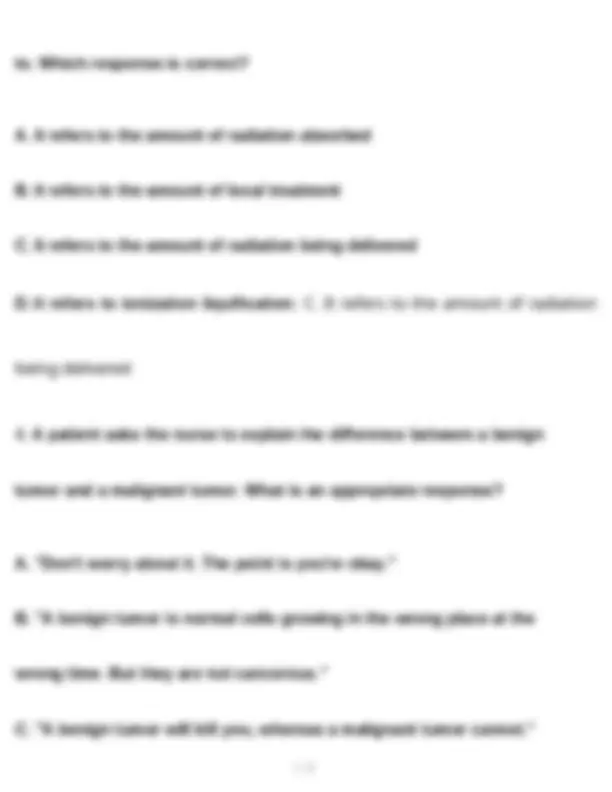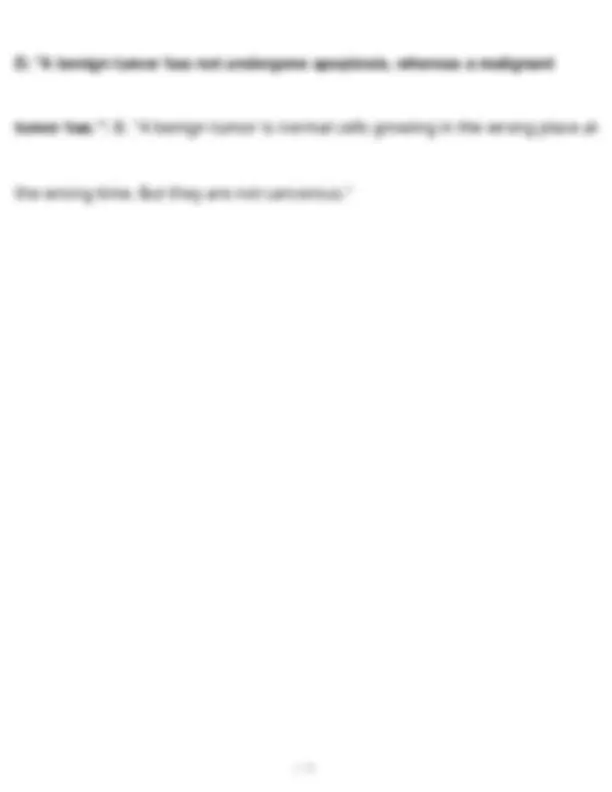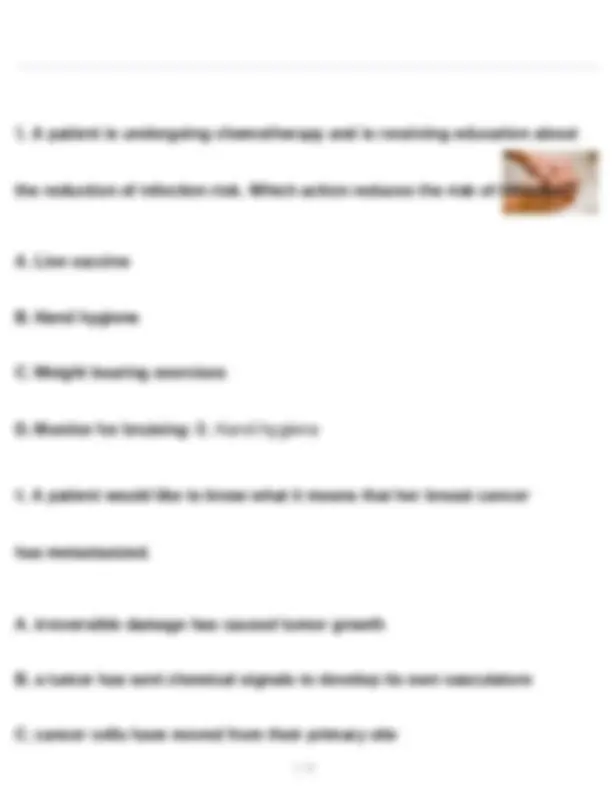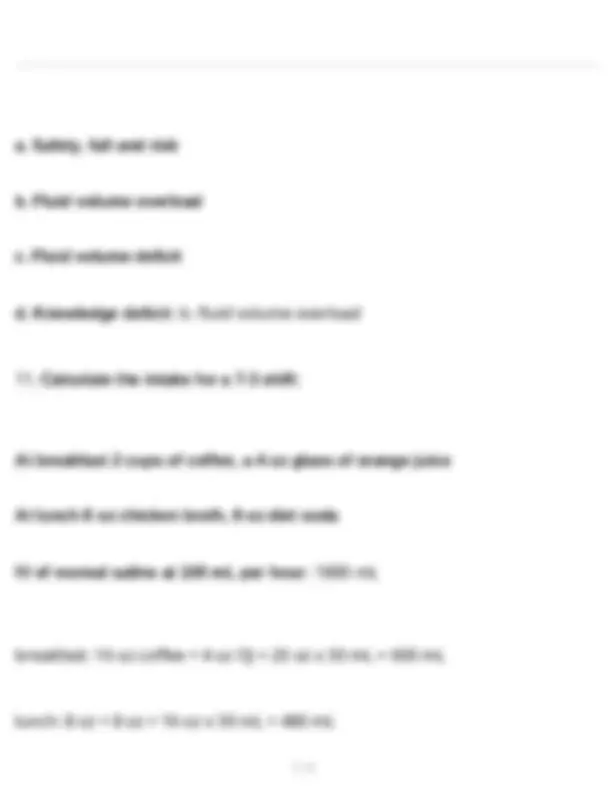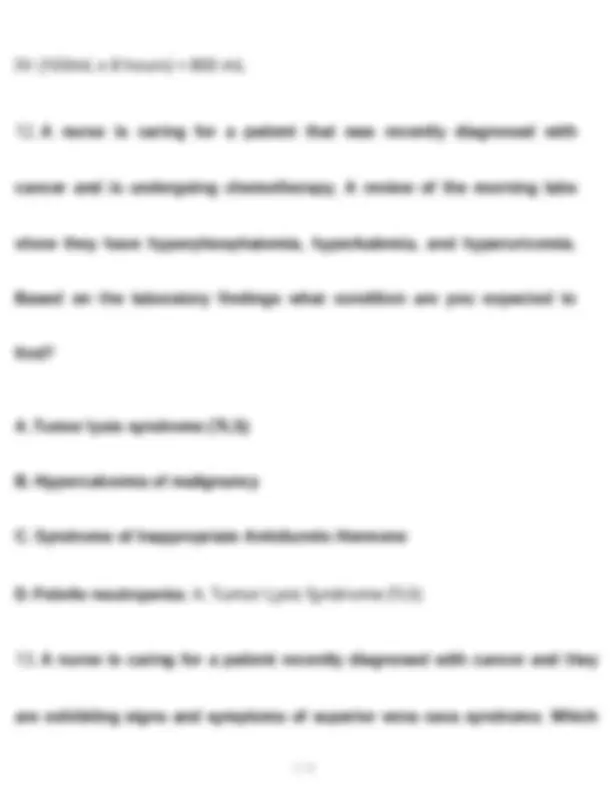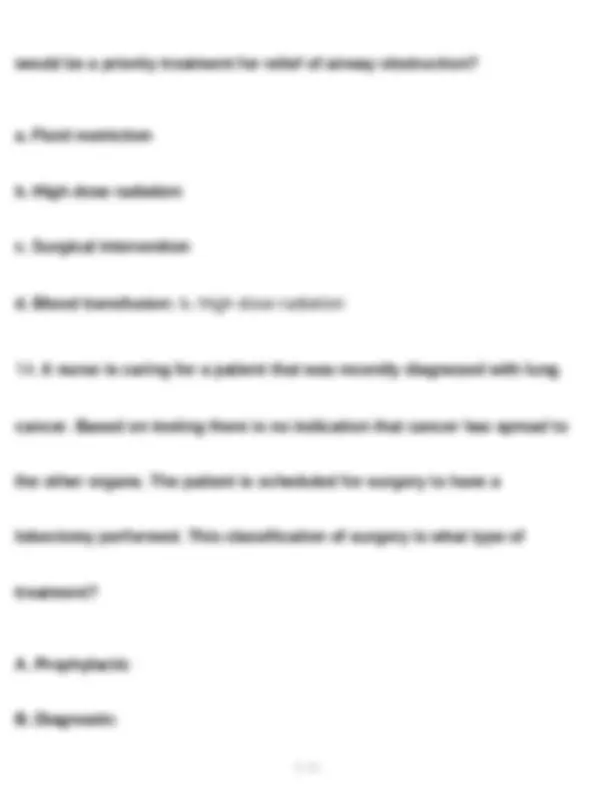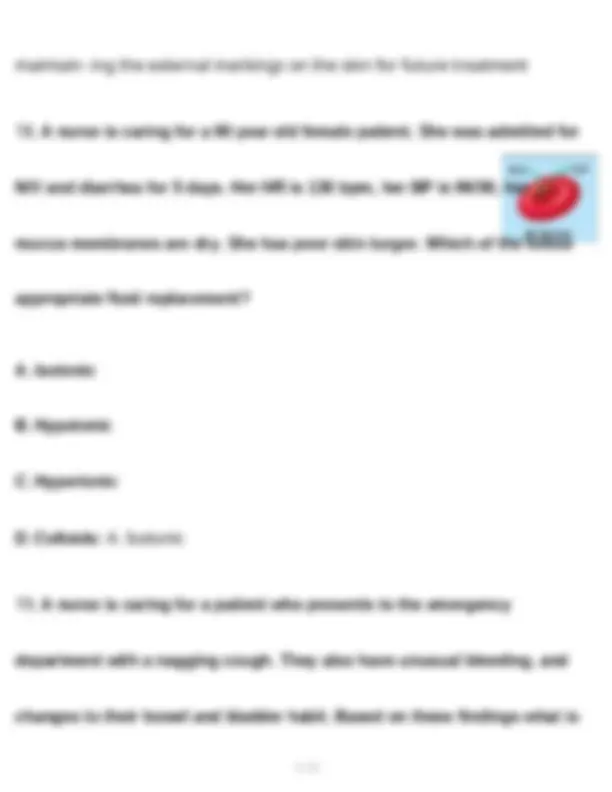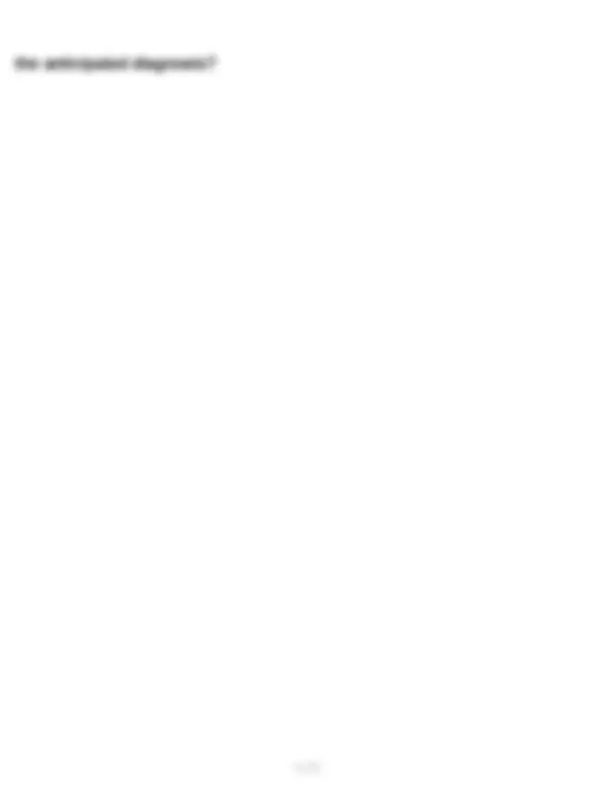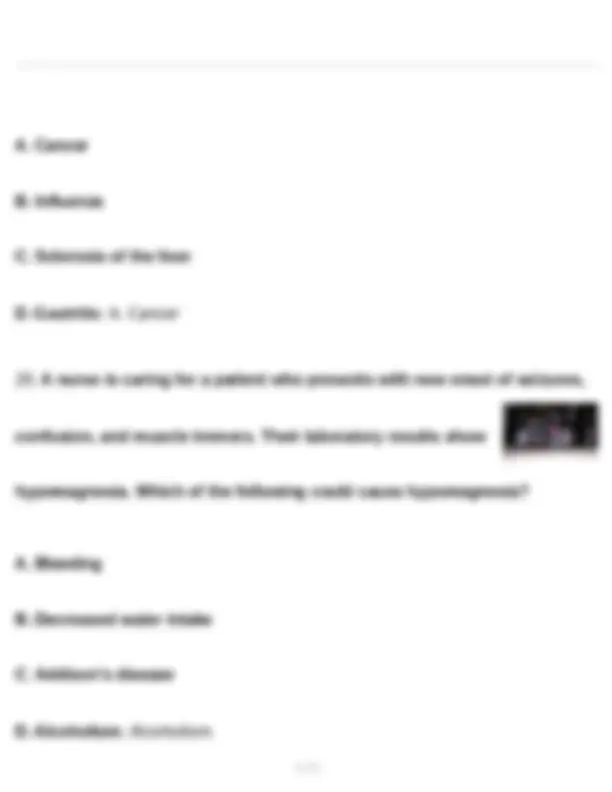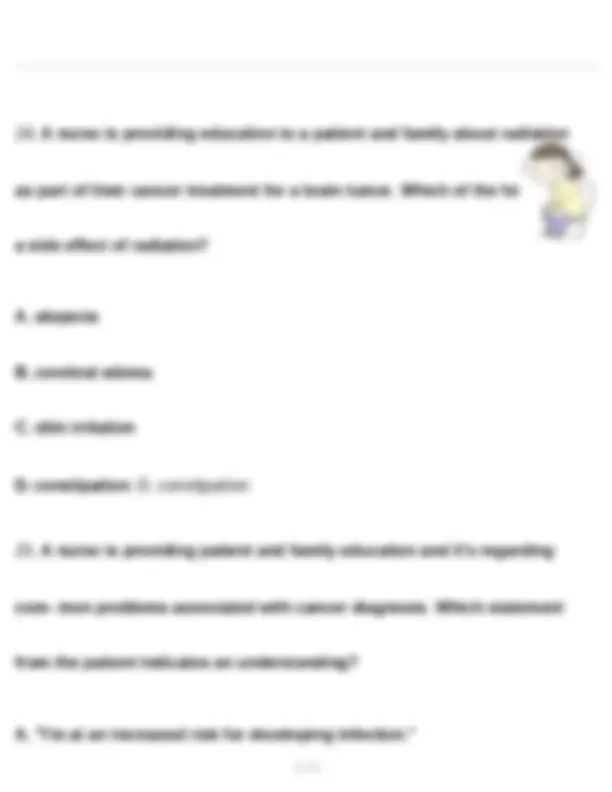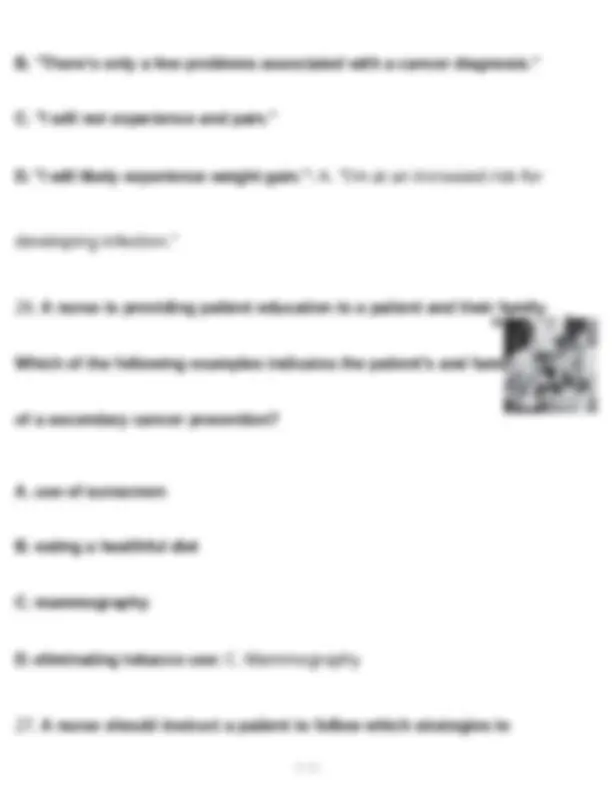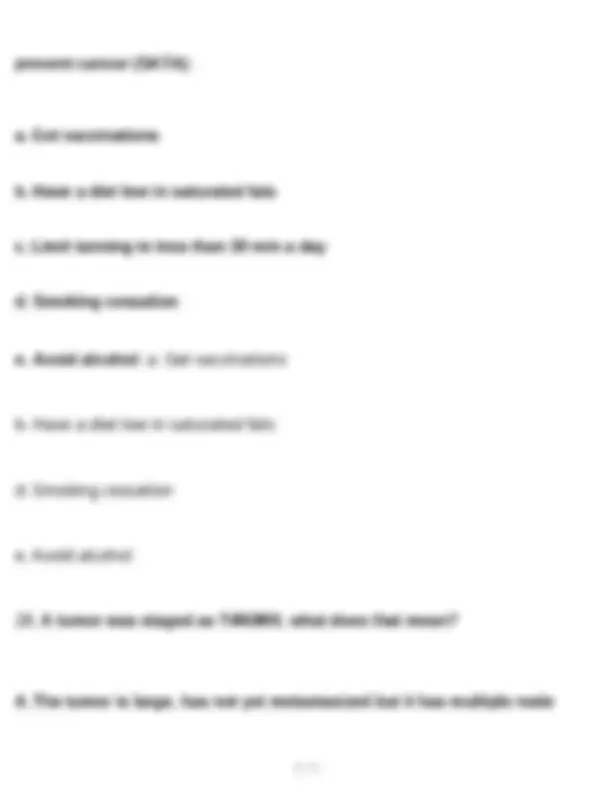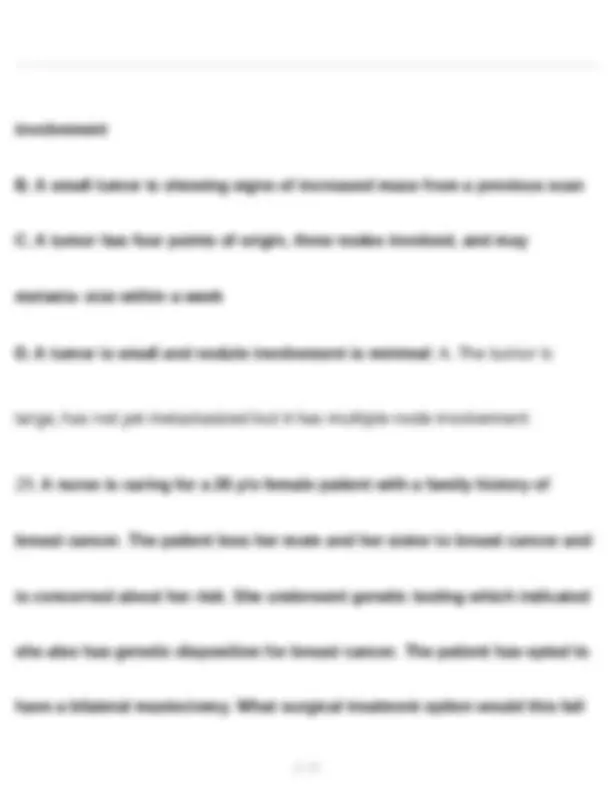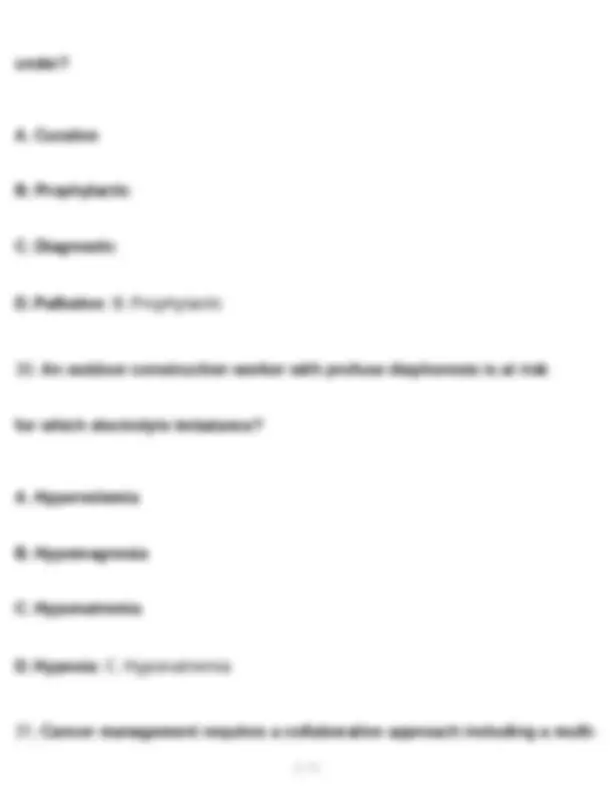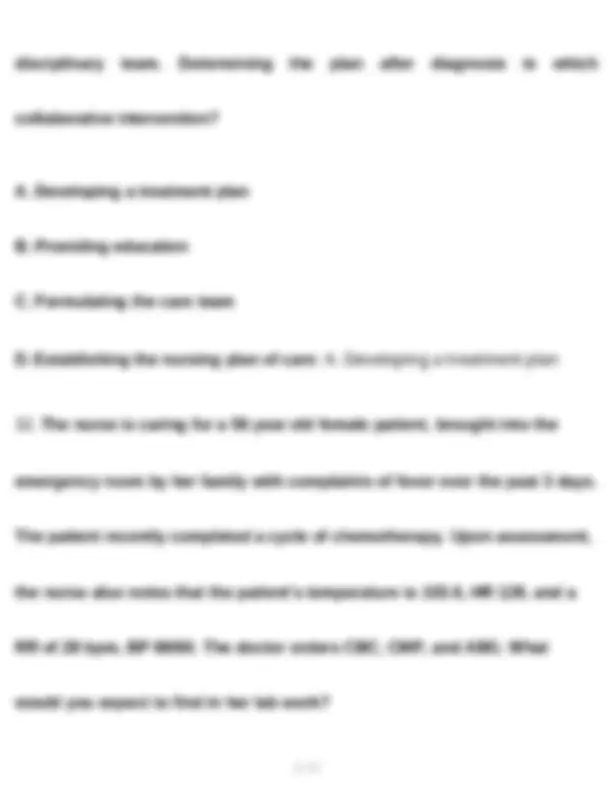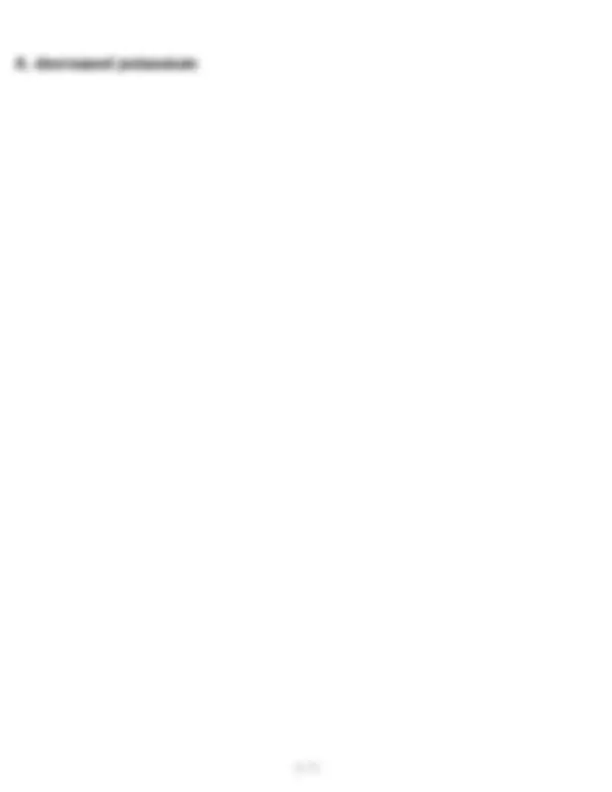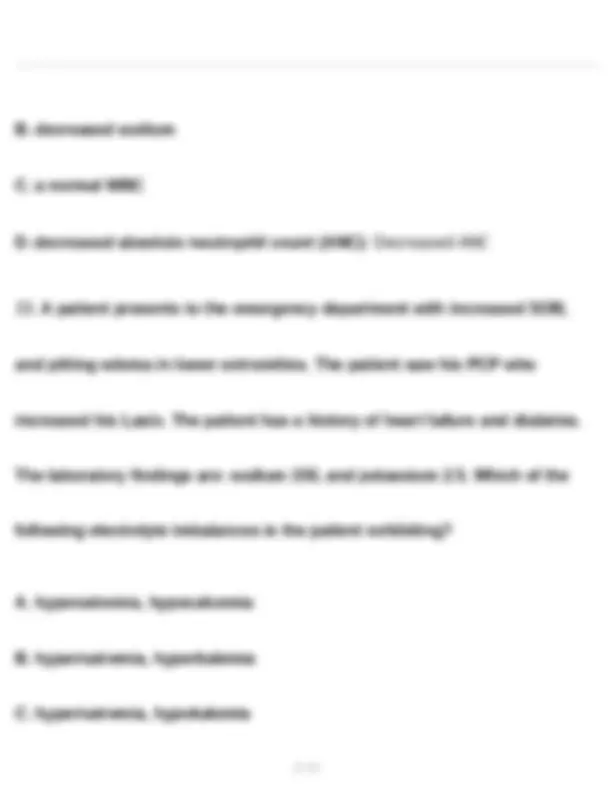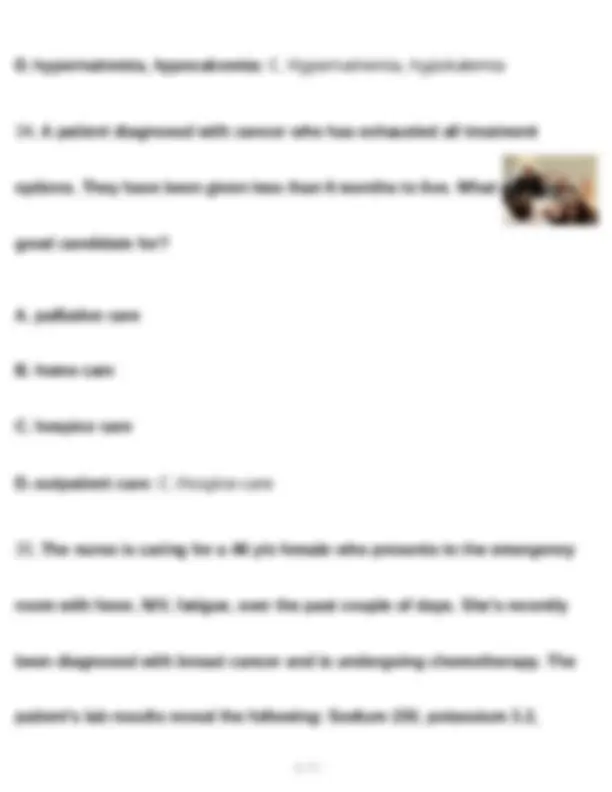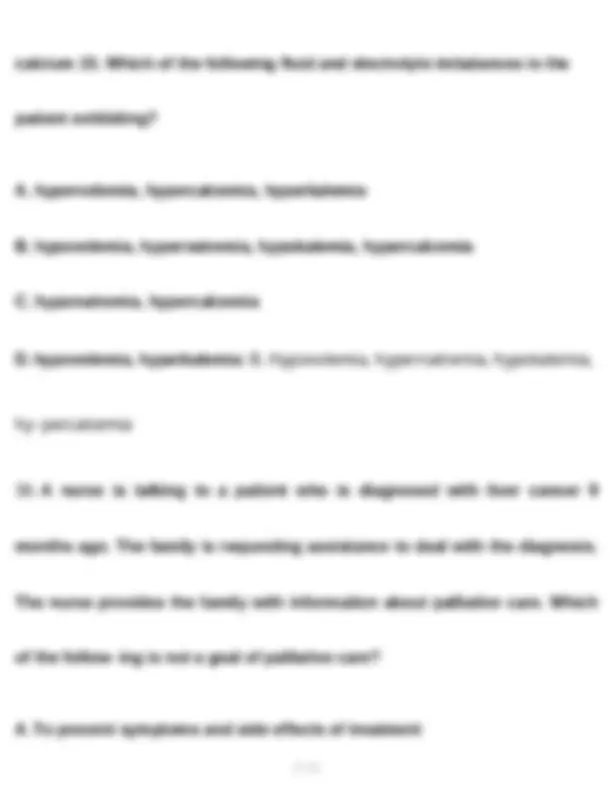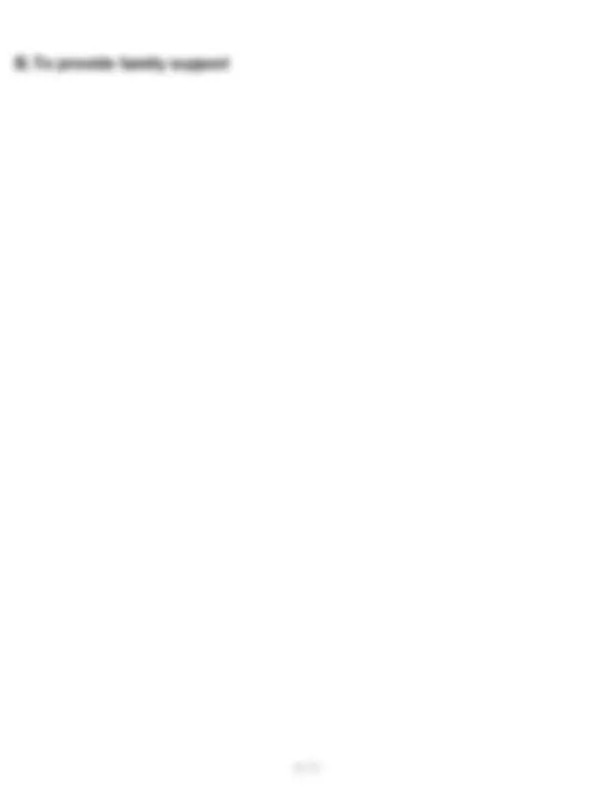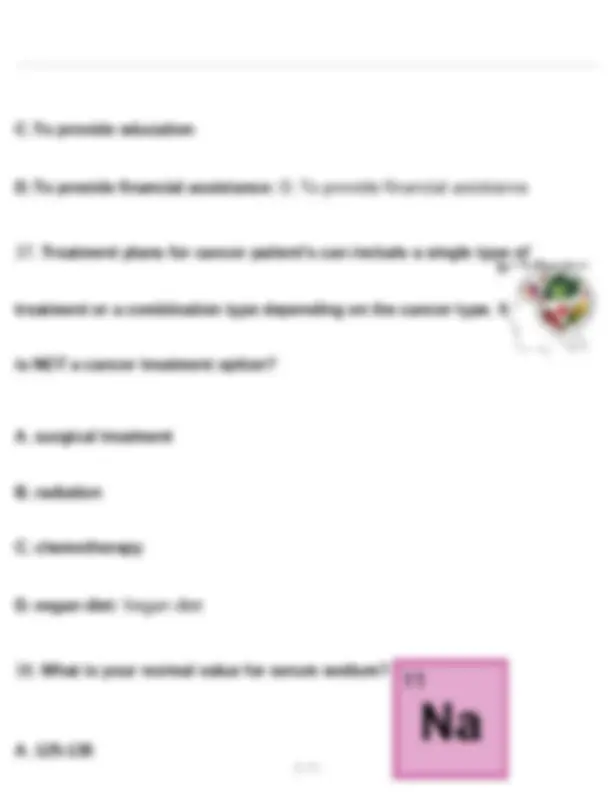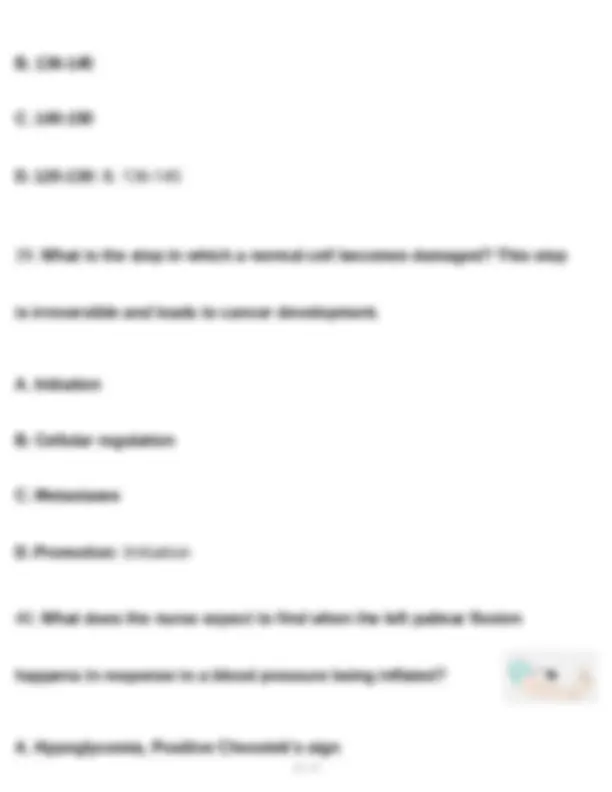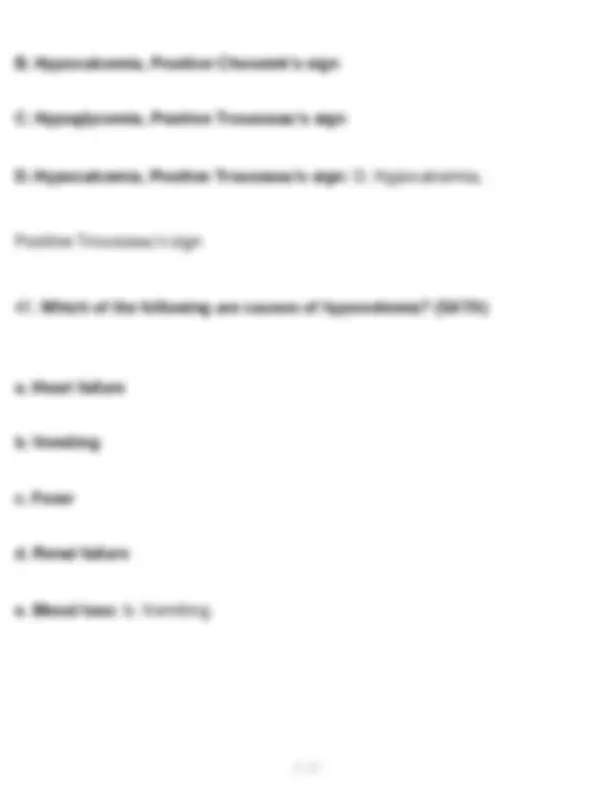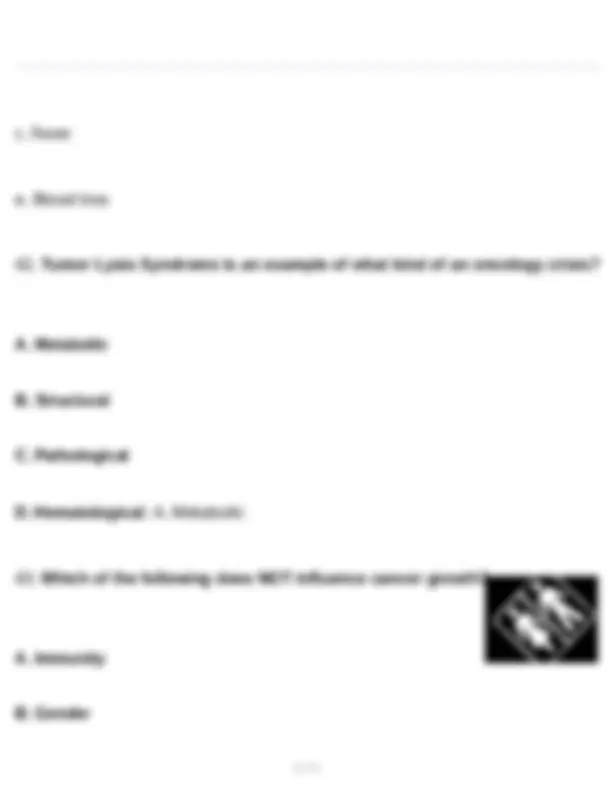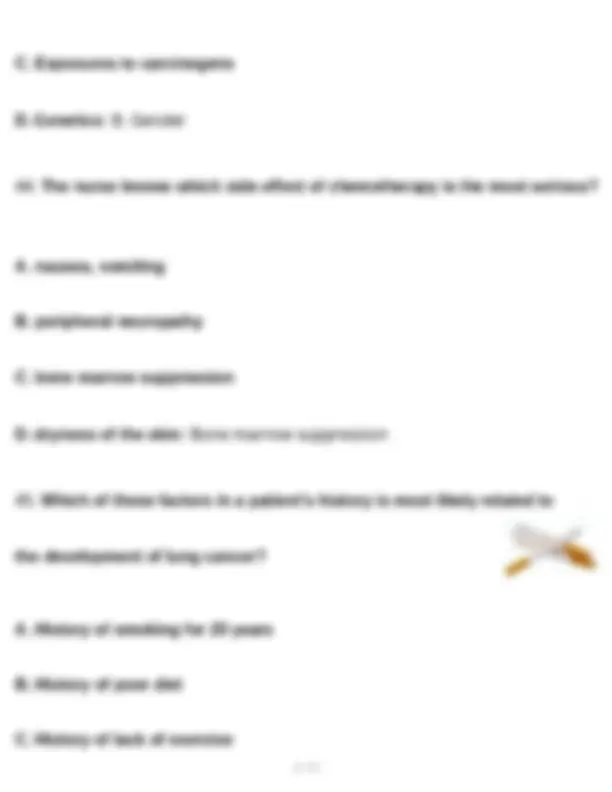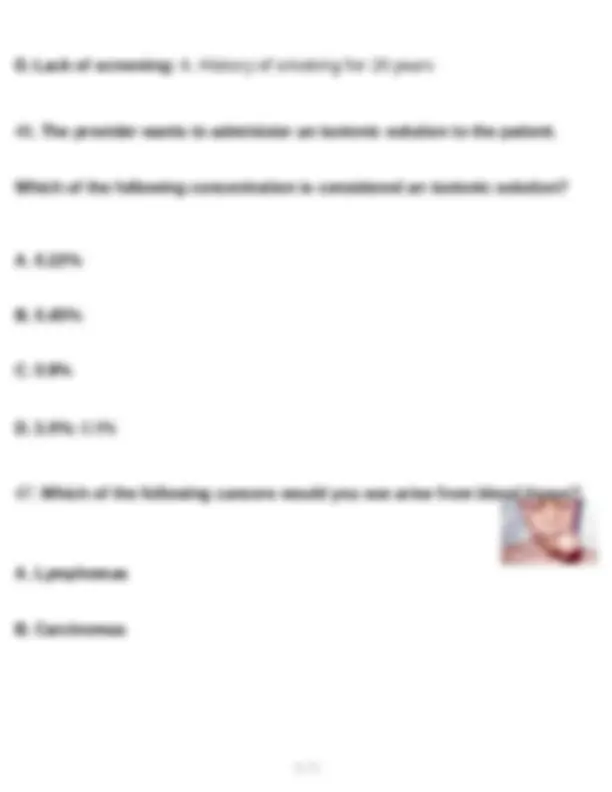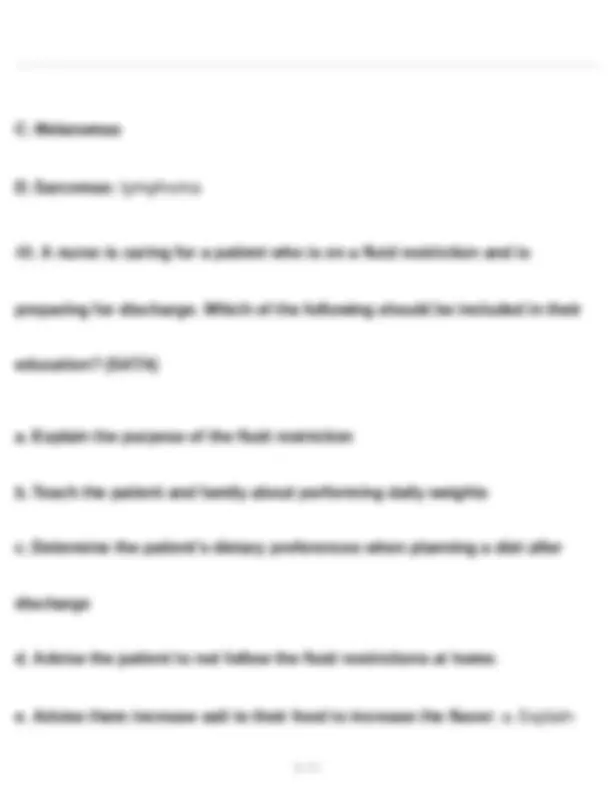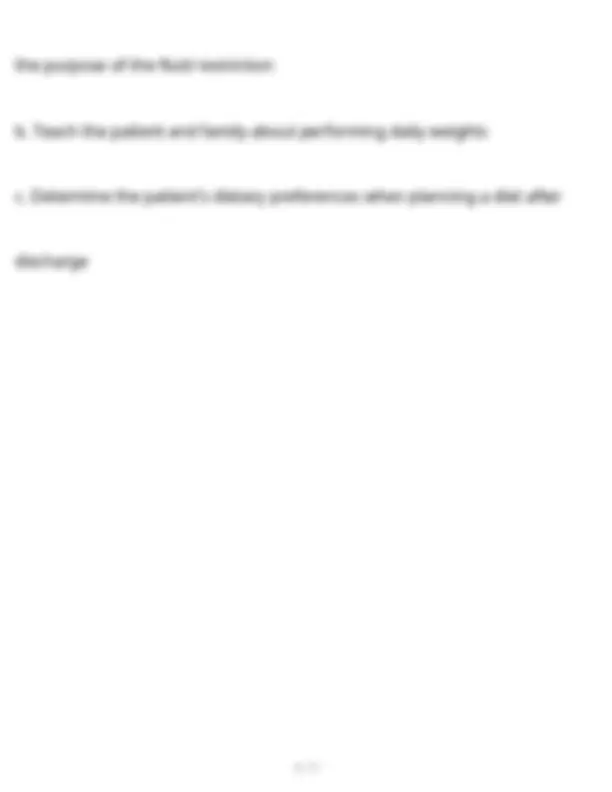Download NUR 2392: Multidimensional Care II - MDC 2 Exam 1 Questions and Answers (2024/2025) and more Exams Nursing in PDF only on Docsity!
NUR 2392 / NUR2392: Multidimensional Care II /
MDC 2 Exam 1 Questions and Correct Answers
(2024 / 2025) (Verified Answers)
- A patient has a positive family history of colon cancer. Which of the follow- ing is a recommendation you would want them to adhere to? A. Encourage baseline colonoscopy screening B. Strict physical activity C. Encourage the patient to increase dietary intake of red meats D. Encourage the patient to reduce intake of fiber: A. Encourage baseline colonoscopy screening
- The patient asks the nurse how radiation works to destroy cancer cells. How would you respond? A.The goal of radiation therapy is to destroy the cancer cells, while minimizing further damage to the body B. The goal of localized radiation therapy is to kill all of the rapidly dividing cells throughout the body C. The goal of radiation therapy is to localize the tumor and reverse it back to normal tissue D. The goal of radiation therapy is to promote cell proliferation: A. The goal of radiation therapy is to destroy the cancer cells, while minimizing further damage to the body
- A patient asks the nurse to explain what radiation "exposure" refers
D. "A benign tumor has not undergone apoptosis, whereas a malignant tumor has.": B. "A benign tumor is normal cells growing in the wrong place at the wrong time. But they are not cancerous."
- A patient is undergoing chemotherapy and is receiving education about the reduction of infection risk. Which action reduces the risk of infection? A. Live vaccine B. Hand hygiene C. Weight bearing exercises D. Monitor for bruising: B. Hand hygiene
- A patient would like to know what it means that her breast cancer has metastasized. A. irreversible damage has caused tumor growth B. a tumor has sent chemical signals to develop its own vasculature C. cancer cells have moved from their primary site
C. Calcium less than 11.0 mEq/L D. Potassium less than 3.5 mEq/L: D. Potassium less than 3.5 mEq/L
- The nurses uses which phrase to describe palliative care? A. care for a patient with a prognosis less than 6 months B. palliative care focuses on end of life patient care C. patient care with a focus on treatment of symptoms D. its client education about relative treatment alternatives: C. Patient care with a focus on treatment of symptoms
- A nurse is caring for a 72 year old female. She has a diagnosis of dehy- dration. Which of the following nursing diagnoses should NOT be included in their plan?
a. Safety, fall and risk b. Fluid volume overload c. Fluid volume deficit d. Knowledge deficit: b. fluid volume overload
- Calculate the intake for a 7-3 shift: At breakfast 2 cups of coffee, a 4 oz glass of orange juice At lunch 8 oz chicken broth, 8 oz diet soda IV of normal saline at 100 mL per hour: 1880 mL breakfast: 16 oz coffee + 4 oz OJ = 20 oz x 30 mL = 600 mL lunch: 8 oz + 8 oz = 16 oz x 30 mL = 480 mL
would be a priority treatment for relief of airway obstruction? a. Fluid restriction b. High dose radiation c. Surgical intervention d. Blood transfusion: b. High dose radiation
- A nurse is caring for a patient that was recently diagnosed with lung cancer. Based on testing there is no indication that cancer has spread to the other organs. The patient is scheduled for surgery to have a lobectomy performed. This classification of surgery is what type of treatment? A. Prophylactic B. Diagnostic
nistration? C. Curative D. Palliative: C. Curative
- A patient has CHF and the have renal failure. Which of these statements by the patient requires further education to avoid hypervolemic episodes? A. "I'm going to monitor my weight daily." B. "I'm going to eat ham instead of chicken." C. "I'll go to the emergency room if I have difficulty breathing.": B. "I'm going to eat ham instead of chicken."
- A nurse is caring for a patient who's being treated for hypokalemia. Which of the following is correct statement regarding potassium admi
ing is an maintain- ing the external markings on the skin for future treatment
- A nurse is caring for a 90 year old female patient. She was admitted for N/V and diarrhea for 5 days. Her HR is 130 bpm, her BP is 96/50, her mucus membranes are dry. She has poor skin turgor. Which of the follow appropriate fluid replacement? A. Isotonic B. Hypotonic C. Hypertonic D. Colloids: A. Isotonic
- A nurse is caring for a patient who presents to the emergency department with a nagging cough. They also have unusual bleeding, and changes to their bowel and bladder habit. Based on these findings what is
the anticipated diagnosis?
or skin
- A nurse is caring for a patient with a diagnosis of hypernatremia. Which of the following assessments would you expect to see? A. Hypothermia B. Increased thirst C. Headache D. Muscle cramping: B. increased thirst
- A nurse is caring for an 84 year old with nausea and they've been vomiting for 3 days. They vomited this morning before they arrived. Upon assessment the nurse notes an elevated HR, dry oral mucus membranes, and po turgor. What is the priority intervention? A. Schedule small feedings
B. Administer antiemetic C. Obtain an order for IV access and start fluids D. Monitor output but documenting episodes of incontinence: C. Obtain an order for IV access and start fluids
- A nurse is caring for a newly diagnosed leukemia patient. They recently completed their first round of chemotherapy. Which of the following would you include in patient and family education? A. The patient is at an increased risk for developing mucositis B. The patient may resume normal activity following discharge C. The patient does not have an increased risk for bleeding D. The patient will not experience any pain as a result of the leukemia: A. The patient is at an increased risk for developing mucositis
nderstanding B. "There's only a few problems associated with a cancer diagnosis." C. "I will not experience and pain." D. "I will likely experience weight gain.": A. "I'm at an increased risk for developing infection."
- A nurse is providing patient education to a patient and their family. Which of the following examples indicates the patient's and family's u of a secondary cancer prevention? A. use of sunscreen B. eating a healthful diet C. mammography D. eliminating tobacco use: C. Mammography
- A nurse should instruct a patient to follow which strategies to
prevent cancer (SATA): a. Get vaccinations b. Have a diet low in saturated fats c. Limit tanning to less than 30 min a day d. Smoking cessation e. Avoid alcohol: a. Get vaccinations b. Have a diet low in saturated fats d. Smoking cessation e. Avoid alcohol
- A tumor was staged as T4N3M0, what does that mean? A. The tumor is large, has not yet metastasized but it has multiple node

